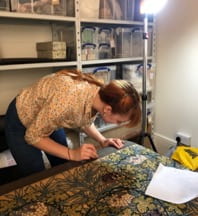
BA Fashion and Dress History student, Katy Crawford, details how she built a profile in volunteer textile conservation to support her career plans.
After stumbling across some painting conservation videos and being completely mesmerised by the process of conserving, preserving and sometimes restoring objects, I wondered if this career path might align with my own interest in fashion and dress, and that is when I discovered textile conservation.
After researching how I could pursue this journey in March 2019, I discovered the only dedicated Textile Conservation qualification is at the University of Glasgow. I knew instantly that this is where I wanted to be after my finishing my BA, but the entry requirements were tough and after speaking to previous and current students, I knew I had my work cut out. There is no doubt that the experience and contacts I gained through volunteering helped me gain a place on my dream master’s degree.

Figure 1: Using an ergo hoover and nylon mesh (to avoid direct contact with the textile) to clean the Acanthus bedspread of a year’s worth of dust. Standen National Trust. Personal photograph of the author. 17th July 2019.
I first contacted the National Trust properties, Nymans and Standen House and Garden, who were delighted to help me in preparation for my master’s application. Through volunteering I gained an introduction to conservation and was able to build my skillset in an environment where there was very little pressure and I had the luxury to simply learn from others. I completed morning cleans, deep cleans and aided in the general upkeep of the house. I also learnt about pests, how to handle and condition check specific objects, and how to talk to visitors about conservation and all the work that goes on behind the scenes.
Volunteering not only expands your skills but also provides you with access to an experience that the general public don’t get. At Standen I carried out an extensive project where I condition reported and pest checked over forty textile items. This included the Acanthus bedspread made by Morris & Co. in 1890, making it conceivable that May Morris herself supervised the work completed on it! At Standen, I was able to view and handle their wonderful Arts and Crafts textile collection, a luxury I earned through gaining the trust of the conservation team.
In addition, I have gained a tremendous amount of contacts by volunteering. Through Nymans I was lucky enough to visit Zenzie Tinker’s conservation studio in Brighton, where I gained invaluable advice from Zenzie and members of her staff who had also completed the Glasgow master’s qualification. I later completed a course with Zenzie on the conservation of electra beetle wing, an insect element sometimes used in fashion and textiles. This in turn put me in touch with further conservators and students. During the Professional Paths module in the final year of my Fashion and Dress History degree, I focused on textile conservation as a career. I was able to interview Zenzie for my final essay, which not only helped me improve my grade but strengthened my relationship with a professional contact.

Figure 2: Inspecting one of the Tulip hangings for pests and signs of new damage. Standen National Trust. Personal photograph of the author. 31st July 2019.
For many, the ultimate goal of volunteering is for it to lead to paid work, and it is possible! After a few months volunteering with Standen, a member of their conservation team handed in their notice and I was offered some paid work while they interviewed for a replacement. This was an incredible opportunity which I would not have received had I not already shown my capabilities through volunteering. I was even encouraged to apply for the full-time role, which I would have been delighted to do had it not clashed with university commitments.
I wholeheartedly encourage students to talk to your university tutors about your career plans. Through my course tutor, Dr Veronica Isaac, I was able to visit the V&A textile conservation studio. This was something I had attempted to do myself with no luck, highlighting how you should make the most of your tutors’ contacts. While visiting, I asked if I could volunteer and the answer was yes! This is an ideal example of ‘if you don’t ask, you don’t get!’ Putting yourself forward demonstrates your commitment and may lead to other opportunities. My experience at the V&A was sadly cut short due to coronavirus but I was able to help with the current decant project, making new storage supports and improving old supports for women’s sixteenth-century hats.
If I could summarise my journey, I would say that volunteering will never be a waste of time. You get the opportunity to expand your skillset, gain hands-on experience and contacts, and maybe even gain paid work. Everywhere I have volunteered I have met someone new, which has led to more places to visit and even more people to meet. Through contacts at the National Trust, I have visited Knole conservation studio, where I did my first interventive conservation work (assessing collections damage), and later this year I will be visiting the National Trust’s dedicated textile conservation studio for a week-long placement. Through contacts at the V&A, I will be visiting the textile conservation studio at the Museum of London. All of these visits and opportunities were made possible through volunteering and being able to name-drop the contacts I have gained over the past year.
A good read and a happy ending !
I have been lucky enough to attend 2 of Zenzies day courses and both have been a combination of information, technique, example and enjoyment.
Enjoy your MA.
Stephanie Richards
Henfield Museum